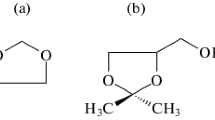Abstract
Dielectric relaxation was examined for aqueous trimethylamineoxide (TMAO) solutions over a wide concentration (c) range. The dielectric relaxation of TMAO was described by a Debye-type function with a relaxation time of about 3 × 10−11 s, with the strength proportional to c. The number of water molecules tightly hydrated to unprotonated TMAO was estimated to be two. Ab initio calculations predict the magnitudes of the dipoles for individual TMAO and TMAO tightly hydrated by two water molecules, to be 4.9 and 4.2 D, respectively. When the amount of HBr added was increased, dielectric spectra were described by two modes with relaxation times, about 3 × 10−11 and the about 8 × 10−10. The fast relaxation was assigned to the rotational mode of unprotonated TMAO tightly hydrated by two water molecules, and the slow mode to the rotational mode of dimers formed between a protonated and unprotonated TMAO due to hydrogen bonding.
Similar content being viewed by others
References
V. V. Daniel, Dielectric Relaxation (Academic Press, New York, 1967).
V. I. Minkin, O. A. Osipov, and Yu. A. Zhdanov, Dipole Moments in Organic Chemistry, W. E. Vaughan, Transl edn. (Plenum, New York, 1970).
E. A. S. Cavell, P. C. Knight, and M. A. Sheikh, Trans. Faraday Soc. 67, 2225(1971).
J. Barthel, H. Hetzenauer, and R. Buchner, Ber. Bunsen-Ges. Phys. Chem. 96, 988(1992).
T. Shikata, S. Imai, and S. Shiokawa, Phys. Chem. B 105, 4495(2001).
E. P. Linton J. Amer. Chem. Soc. 62, 1945(1940).
G. M. Philips, J. S. Hunter, and L. E. Sutton, J. Chem. Soc., p. 146(1945).
A. Haaland, H. Tomassen, and Y Stengstroem, J. Mol. Struct. 263, 299(1991).
R. Noto, V. Martorana, A. Emanuele, and S. L. Fornili, J. Chem. Soc. Faraday Trans. 91, 3803(1995).
K. M. Kast, S. Reiling, and J. Brickmann, J. Mol. Struct. 453, 169(1998).
S. F. Boys and F. Bernardi, Mol. Phys. 19, 533(1970).
H. Fröhlich, Theory of Dielectrics (Oxford University Press, London, 1958).
L. Onsager, J. Amer. Chem. Soc. 58, 1486(1936).
J. G. Kirkwood, J. Chem. Phys. 7, 911(1939).
R. Buchner, J. Barthel, and J. Stauber, Chem. Phys. Lett. 306, 57(1999).
U. Kaatze and R. Pottel, J. Mol. Liquids 49, 225(1991).
J. N. Israelachivili, Intermolecular and Surface Forces, (Academic Press, New York, 1985), Chap.4.
R. Pottel, Water, Vol. 3, F. Franks, f. ed. (Plenum, New York, 1973), Chap. 8.
T. Shikata and S Imai, Langmuir 14, 6804(1998).
S. Imai and T. Shikata, Langmuir 15, 8388(1999).
M. J. Frisch, G. W. Trucks, H. B. Schlegel, G. E. Scuseria, M. A. Robb, J. R. Cheeseman, V. G. Zakrzewski, J. A. Montgomery, Jr., R. E. Stratmann, J. C. Burrant, S. Dapprich, J. M. Millam, A. D. Daniels, K. N. Kudin, M. C. Strain, O. Farkas, J. Tomasi, V. Barone, M. Cossi, R. Cammi, B. Mennucci, C. Pomelli, C. Adamo, S. Clifford, J. Ochterski, G. A. Petersson, P. Y. Ayala, Q. Cui, K. Morokuma, D. K. Malick, A. D. Rabuck, K. Raghavachari, J. B. Foresman, J. Cioslowski, J. V. Ortiz, A. G. Baboul, B. B. Stefanov, G. Liu, A. Liashenko, P. Piskorz, I. Komaromi, R. Gomperts, R. L. Martin, D. J. Fox, T. Keith, M. A. Al-Laham, C. Y. Peng, A. Nanayakkara, C. Gonzalez, M. Challacombe, P. M. W. Gill, B. Johnson, W. Chen, M. W. Wong, J. L. Andres, C. Gonzalez, M. Head-Gordon, E. S. Replogle, and J. A. Pople, Gaussian 98, Revision A. 7 (Gaussian, Pittsburgh, PA, 1998).
T. Clark, A Handbook of Computational Chemistry (Wiley, New York, 1985), Chap. 5.
C. Møller, M. S. Plesset, Phys. Rev. 46, 618(1934).
H. Yoshida and H. Matsuura, J. Phys. Chem. 102, 2691(1998).
T. C. W. Mak, J. Mol. Struct. 178, 169(1988).
K. M. Harmon and J. Harmon, J. Mol. Struct. 78, 43(1982).
J. L. Oncley, Chem. Rev. 30, 433(1942).
R. Pethig, Dielectric and Electric Properties of Biological Materials, (Wiley, New York, 1979), Chap. 3.
Z. Mielke, Spectrochim. Acta 42A, 673(1986).
U. Kaatze, Ber Bunsen-Ges. Phys. Chem. 77, 447(1973).
Author information
Authors and Affiliations
Rights and permissions
About this article
Cite this article
Shikata, T., Itatani, S. Dielectric Relaxation of Aqueous Trimethylamineoxide Solutions. Journal of Solution Chemistry 31, 823–844 (2002). https://doi.org/10.1023/A:1021349411687
Issue Date:
DOI: https://doi.org/10.1023/A:1021349411687




